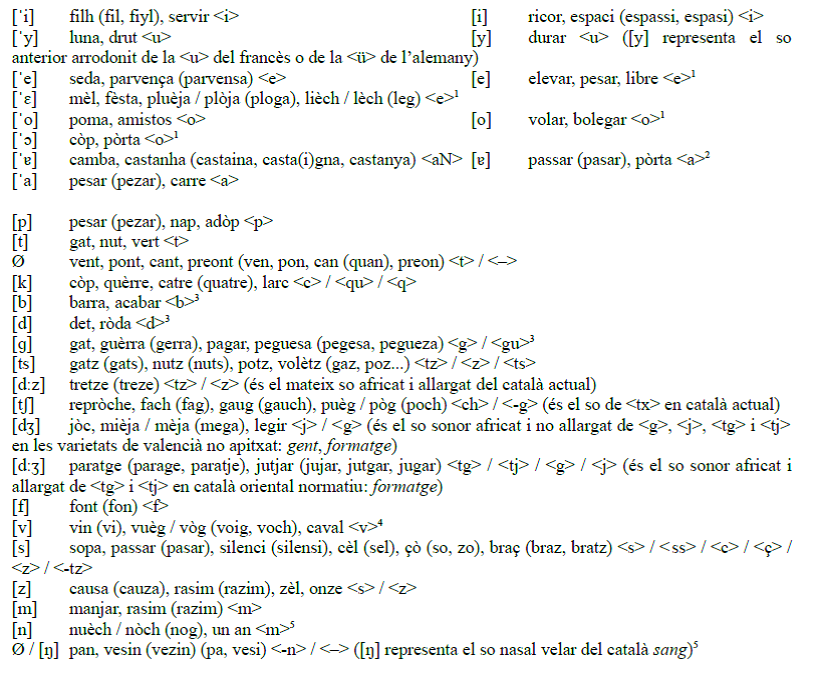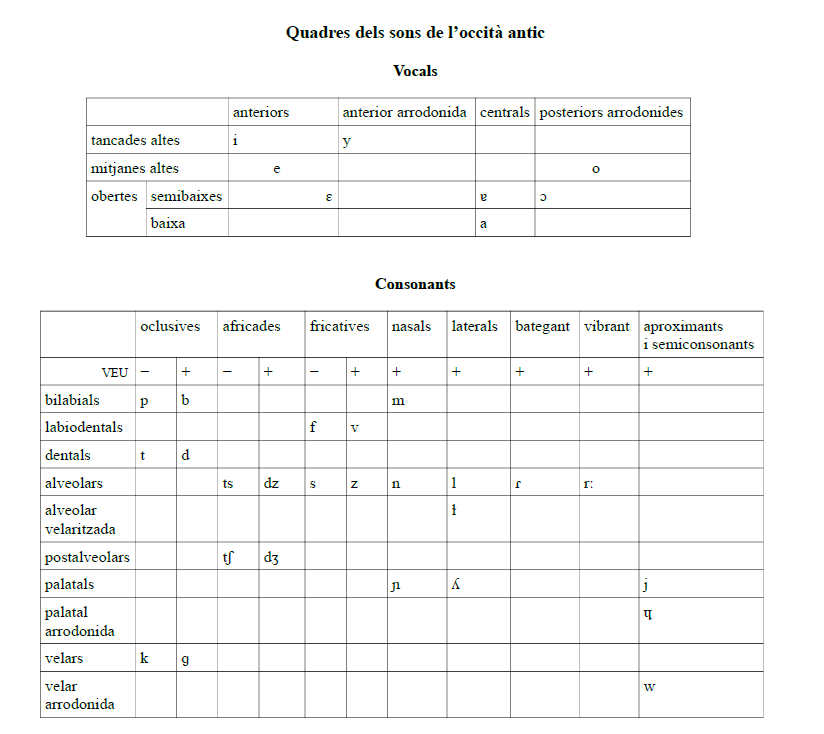
Old Occitan pronunciation and spelling
Old Occitan pronunciation and spelling
In the following table, we provide a reconstruction of the pronunciation of troubadour Occitan, based on what we can deduce about the phonetic evolution of the language and on what we can glean from medieval treatises on the subject. Phonetic transcriptions are given for Occitan vowels (stressed and unstressed), consonants, and semivowels together with some examples. Square brackets are used for pronunciations ([y]) and angle brackets for spellings (< n >). A dash within angle brackets < ‒ > is used to indicate an alternation between either the absence or presence of a letter; thus < t >
It is important to bear in mind, however, that a reconstruction like this can only be an approximation. Furthermore, the fact that the troubadours composed over a considerable period of time and over a wide geographical area implies a notable degree of linguistic variation; in addition the surviving texts are found in later copies which are of course subject to the changes we would expect in textual transmission. This reconstruction of the pronunciation, therefore, has to be seen as an educated estimate which incorporates information from medieval treatises, and so to a certain extent takes on board the conventions expounded therein.
Those who wish to use the information in this table as an aid to singing or reading aloud the poems of the troubadours can adapt it for practical use: for example, a native Catalan reader does not need to make the distinction between an open and closed a (note 2), nor between an l that is velarised and one that is not (note 6); nor maintain the plosive pronunciation of b, d and g (note 3). On the other hand, because of the rhymes, it is important to distinguish correctly between the pronunciation of open and closed e and o (note 1) which have a distribution different to those found in the several varieties of modern Catalan (with the exception of a small northern area with respect to the o). For those who wish to prepare a reading of the poems, Levy’s dictionary (1909) systematically records the vowel timbres.


Notes
(1) In troubadour Occitan, as in Catalan, there was an opposition between open e and o —[ɛ], [ɔ]— and the closed equivalents —[e], [o]—, neutralised in an unstressed position as in the western varieties of modern Catalan. At the beginning of the 14th century, the closed o [o] had already changed to [u], generalised in Occitan today: in the Leis (I, 16) it says that if Latin conventions were to be followed, nom, plom and pom ('name', 'feather', and 'apple' or 'doorknob') would have to be written with a u, but that, following known usage ('usatge'), they were written with an o. As a guide, grave accents are added to the open timbre e and o (mèl, còp); these accents, of course, do not appear in ancient texts.
(2) Medieval treatises distinguish a closed a (presumably [ɐ]) from an open a ([a], cf. Leis I, 16). A stressed a before a nasal consonant was closed (camba ['leg'], castanha ['chestnut']) as was an unstressed a. This distribution is currently found represented by an open back unrounded vowel ([ɑ]) and its rounded equivalent ([ɔ]) in the northern Languedocien and Limousin dialects.
(3) The current Languedocien and Gascon varieties —remembering, however, that the specific traits of Gascon were excluded from the troubadour language— have the same alternations between occlusive and approximant articulations of /b/, /d/ and /ɡ/ (combat [kumˈbat] / acabar [akaˈβa], pendís [penˈdis] / badar [baˈδa], fangós [faŋˈɡus] / pagar [paˈɣa]) found in most varieties of Catalan. In the convention adopted here, we presume that the articulation of these phonemes was always occlusive, as it is today in Provençal and the northern varieties.
(4) The current Languedocien and Gascon varieties do not feature the labiodental phoneme /v/. Here we presume that the old letter < v >
(5) In the troubadour texts that have survived, we find the final < n >
(6) The distinction between the two types of l (/l/ ~ /ɫ/) is prescribed in the medieval treatises, such as the Leis (I, 38), where we read 'This letter l is pronounced strongly in cautela, sala, mal, and mala, but softly in piucela, renoela, caval, and cala'. The l of the first list of examples comes from a single Latin L and should be pronounced as a velarised l ([ɫ] in IPA) according to what we know about the pronunciation of Latin and its evolution: it is the [ɫ] we find in Catalan (mal, mala). The l of the second list, on the other hand, derives from a Latin double L and should be pronounced [l]: etymologically it corresponds to the [ʎ] in Catalan (cavall, calla). Some northern dialects, particularly those of the High Auvergne now have a change from the old velarised l ([ɫ]) when it is between vowels: pala pronounced [ˈpaɣɐ], [ˈpawɐ], [ˈpavɐ]... depending on the zone, but bèla ('beautiful') and novèla ('new') are pronounced as [l]. In the troubadour texts, word-ending [ɫ] often appears vocalised as [w]: mau, sau. This vocalisation is now found in Gascon and, extended to other cases of final l, in some northern zones and in Provençal.
(7) In the medieval texts, the final r is regularly preserved in writing, which indicates that it was also kept in the pronunciation. Currently most of the Occitan linguistic domain has dropped this consonant, as has happened in an extensive area of the Catalan-speaking territory.
(8) With regard to the diphthongs iè ( < [ˈɛ]), uè ( < [ˈɔ]) and uò ( < [ˈɔ]), in the troubadour texts we find an alternation between diphthong and non-diphthong forms: liech / lech, plueja / ploja, uech / uoch / och, fuoc / foc.

Xavier Lamuela (2017)
Bibliography
- Anglade, Joseph (1921), Grammaire de l'ancien provençal, reprint. Paris: Klincksieck, 1977.
- Bec, Pierre (1995), La langue occitane, "Que sais-je?" 1059, 6th ed. [1st ed. 1963]. Paris: PUF. [Catalan translation (out of print): La llengua occitana. Barcelona: Edicions 62, 1977]
- Jensen, Frede (1972), From Vulgar Latin to Old Provençal. Chapel Hill: University of North Carolina Press.
- Leis: Molinier, Guilhem (1356), Las flors del gai saber estier dichas las leys d’amor, 3 vols, Adolphe-Félix Gatien-Arnoult (ed.). Tolouse: J.-B. Paya, 1841, 1842, 1843. [facsimile: Slatkine: Geneva, 1977]
- Levy, Emil (1909), Petit dictionnaire provençal - français, 4th ed. Heidelberg: Carl Winter, 1966.
- Ronjat, Jules (1930–1941), Grammaire istorique des parlers provençaux modernes, 4 vols. Montpellier: Société des Langues Romanes, 1930, 1932, 1937, 1941. [reprint: Slatkine, Geneva, 1980]
